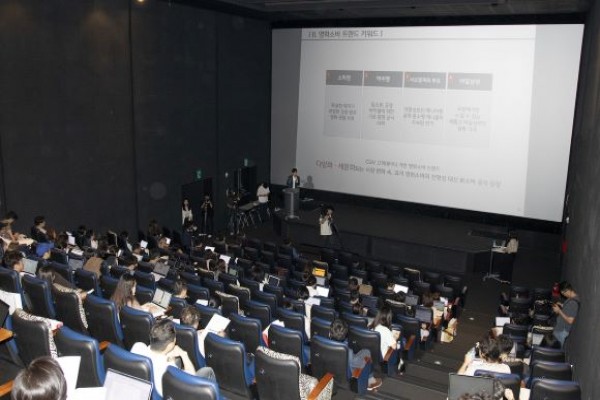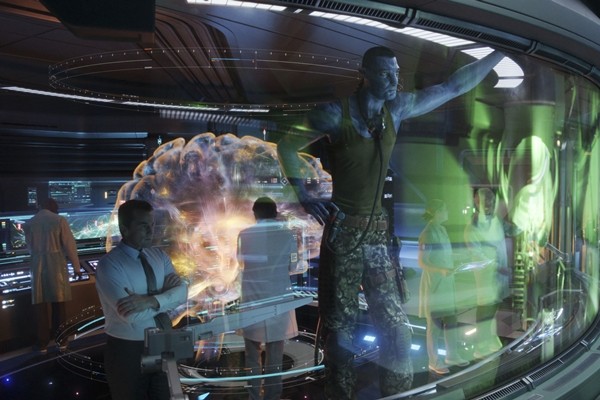130, Suyeonggangbyeon-daero,
Haeundae-gu, Busan, Republic of Korea,
48058
NEWS & REPORTS
Film Exhibitors Find Survival Strategies for Today and Tomorrow
- Writerby Kim Seonghoon
- View1617
Deep dive into the premium large-screen formats offering of Korean exhibitors

(Image: CJ CGV)
Could this hint at a new paradigm for the film exhibition industry in the age of the Covid-19 endemic? Or is it the efforts of the cinema to bring the audience back that are suddenly paying off? Avatar: The Way of Water passed the 10-million-admission mark on January 24 (based on KOFIC’s integrated cinema admission network). It is the first movie to do so this year, and only the second title to achieve this elusive threshold since the beginning of the pandemic after The Roundup last year. With KRW 137.5 billion (around USD 103 million) in total sales accumulated as of March 8, Avatar: The Way of Water is now ranked second among the highest-grossing films of all time, even surpassing the most watched film, Roaring Currents. This is just shy of KRW 2 billion behind Extreme Job, which currently sits in first place, so the top position is still in reach. The blockbuster film earned a total of USD 2.283 billion (according to Box Office Mojo as of March 8), making it the 4th highest-grossing theatrical release worldwide. One has to wonder if the succes of this title wasn’t that it returned to the kind of visual spectacle that had been a rare sight in recent years. Perhaps this is why industry representatives worldwide predicted that the fortunes of the film exhibition sector would rely heavily on the performance of this single title, Avatar: The Way of Water, even before its release.
“There is an explosive demand not only for 3D but also for premium large formats (PLF) such as IMAX and 4DX (a system by which practical effects like moving seats, wind, strobe-lights, fog, scents and vibrations can be used to augment the screening).” According to one CJ CGV representative, the commercial success of Avatar: The Way of Water might indicate that the exhibitors have successfully put strategies into practice for driving the audience back to cinema in the endemic era. “We make films for big screens. People look for entertainment to escape from reality, and small screens of mobile or home devices have limitations. In theaters, you are completely immersed in the world of images, characters and stories.” As Avatar: The Way of Water Producer Jon Landau said, in order to fully appreciate the film the way James Cameron intended, many people shouldn't hesitate to enjoy movies in the best premium auditoriums, such as the Dolby Cinema Hall at Megabox Coex or the Laser IMAX at CGV Yongsan. Even though the price of a ticket is twice as expensive as that of regular theaters.
In fact, the impact Avatar: The Way of Water had on the business of PLF auditoriums is huge. First, 17.5% of the CGV customers who saw Avatar: The Way of Water were in an IMAX theater, while 13.1% watched the film in 4DX and 5.1% in a ScreenX hall (a multi-projection technology that creates an immersive 270-degree viewing experience by projecting images onto the left and right walls of a theater, in addition to the screen at the front). Put together, the proportion of spectators who opted for these formats amounts to 35.7%. When you add people who watched the movie in 3D, this proportion reaches over 60%. A representative from CGV said, "When it comes to our 4DX screenings for Avatar: The Way of Water, the seat occupancy rate reached a whopping 83%." A rate of 30% to 40% is regarded as high, so going over 80% means that every theater was almost full. A large number of viewers flocked to premium auditoriums, regardless of the high price, because they perceived this as an extraordinary experience rather than just a movie-watching act.

(Image: Megabox)
Lotte Cinema announced that their newly refurbished World Tower Superplex alone sold more than 50,000 tickets for Avatar: The Way of Water, with a seat occupancy rate of 62.5% over the 50 days from the film’s release. Their PLF offering, which also includes technologically augmented auditoriums like Super 4D and Super S and service-based halls such as Charlotte (theaters that offer a range of amenities such as spacious seating, high-quality sound and projection systems, and food and beverage options) and Cine Family (private seating areas similar to luxury boxes located at the back of an auditorium and furnish for a comfort similar to a living room), had on average a seat occupancy rate 30% higher than that of normal auditoriums.
Megabox also said that there were a particularly large number of people who chose their Dolby Cinema over other auditoriums to watch Avatar: The Way of Water. Dolby Cinema, which has a total of 1,448 seats in 5 auditoriums across the country, recorded an average seat occupancy rate of 65.9% between December 14th and January 24th. With Avatar: The Way of Water, these theaters attracted 176,000 viewers and achieved gross of about KRW 3.2 billion. This is a particularly high figure considering that the seat occupancy rate of Dolby Cinema theaters for the movie Top Gun: Maverick was only 49.4%. This is now the highest result among all films released since the opening of the first Dolby Cinema, in Seoul COEX.
The commercial success of Avatar: The Way of Water on the earnings of premium large formats is related to a more general tendency, which started during the pandemic. People want from theaters unique experiences that they couldn’t have from a mobile screen or in their living room. “This is not limited to PLF technologies such as IMAX, ScreenX, and 4DX; high-end premium theaters like Gold Class (luxurious and upscale theaters with spacious seating and gourmet food delivered to your seat), Tempur Cinema (theaters with a high level of comfort to bed-like adaptable seats made in collaboration with Tempur), Stressless Cinema (theaters equipped with reclining massage seats, designed to provide a relaxing and stress-free environment), and Private Box (private rooms similar to Cine Family) have also been showing positive results,” CGV said. “The seat occupancy rate in these high-end premium theaters was significantly higher than that of regular theaters. Last year, Gold Class and Stressless Cinema both recorded a seat occupancy rate nearly twice as high as normal hall, while for Tempur Cinema that figure was 2.5 times higher. In the case of Private Box, the rate exceeded 4 times that of normal theaters, indicating it was almost always sold out.”
"With the popularity of premium theaters, including the World Tower Superplex, we confirmed that there is a strong demand for the best movie-watching environment that allows for full immersion”, Lee Shinyoung, the head of Lotte Cinema's communication department, added. "We do our best to offer a viewing experience unlike no other, especially the kind of experience that can only be had in a movie theater.”

(Image: Lotte Cinema)
However, it remains to be seen whether the 3D screenings of Avatar: The Way of Water will have a similar effect as its predecessor, or whether it will present a new paradigm for exhibitors in the endemic era. As is well known at this point, it was James Cameron's previous film Avatar (2000) that compelled multiplexes all around the world to invest massively in new technologies such as IMAX and 4DX. The commercial success of Avatar, which grossed KRW 124.8 billion in Korea alone at the time, led to multiplexes equipping 30% of their screens with 3D projection systems. In keeping with the trend, they have installed a variety of technologies such as IMAX, 3D, 4DX, SoundX, ScreenX, and Aura. Korea’s three major multiplex chains, CGV, Lotte Cinema, and Megabox have invested massively in projection systems to fully accommodate all the 3D movies after Avatar. However, everyone's expectations that 3D would become the bread and butter of exhibitors turned out to be wrong. A Christmas Carol (2009), Harry Potter and the Deathly Hallows (2010), Titan (2010), The Lion King 3D (2011), Transformers 3 (2011), The Hobbit: An Unexpected Journey (2012), etc. all failed both critically and commercially except for A Christmas Carol. It wasn't until James Cameron came back 13 years later with Avatar: The Way of Water that the 3D technology finally returned to the limelight.
The fact that exhibitors spared no expenses on new movie-watching systems such as PLF might stem from some sort of existential crisis. The theater industry has struggled stay afloat and the boundary between movies and series is blurred. Multiplexes have started to program concerts - IM HERO THE FINAL (the concert of trot singer Lim Youngwoong), Pinkfong Sing-Along Movie 2: Wonderstar Concert and BTS: Yet To Come in Cinemas - as well as live stage recordings of musicals like Midnight Sun, Altar Boyz and The Devotion of Suspect X. It shows that they are desperate to bring back spectators by any means, in dire need for new movie releases. Asking for a higher admission fee instead of reducing their capacities, and installing luxury seats so that viewers can lie down or enjoy a full course meal while watching a movie, were to rebrand theaters as more than just places for movie-watching.

(Image: Walt Disney Company Korea)
Avatar: The Way of Water gave the film exhibition industry a glimmer of hope in the current difficulties. With James Cameron's next film Avatar 3, Universal Studios and Nintendo’s The Super Mario Bros. Movie, and Wish, which will celebrate Disney's 100th anniversary, from Frozen Director Chris Buck and voiced by Ariana DeBose, the current line-up of 3D movies for this year and beyond is a sign that the demand for 3D screenings and PLF experiences may well be a lasting trend.
Just as theaters are constantly evolving and seeking ways to ensure their survival, there is a treasure trove of new experiences that can be enjoyed at home, like interactive experiences, video games, virtual reality and extended reality. Netflix has been venturing into the interactive experience with titles such as This Is A True Story, the You vs. Wild series, and Black Mirror: Bandersnatch. In these interactive shows, viewers can create their own narratives by choosing the branching paths they want to take, similarly to the PlayStation game Detroit: Become Human. Extended reality experiences are not yet as easily accessible to the general public as TV shows or movies since they require specific VR equipment. By the same token, it is important for the industry to present more life-like content accessible both in theaters and from their living rooms.













